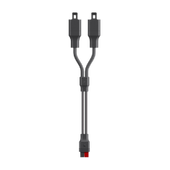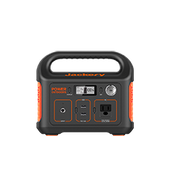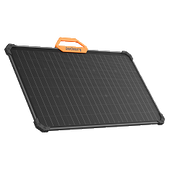From personal desktops to gaming laptops, the power supply unit (PSU) helps convert the electrical energy from the outlet into a stable power source for various components. If you are an electrical engineer or assembling your gaming system, you must wonder about the computer power supply and its impact on system performance and overall functionality.
If you live in areas that experience extended periods of blackouts or are moving to an off-grid location, you will require a stable and portable power unit to supply power to your computer and other electronics. A Jackery Portable Power Station is a portable unit that helps quickly charge the computer and its components without adversely affecting the internal circuitry.
What Is a Computer Power Supply?
A computer power supply, commonly referred to as a power supply unit (PSU), is an important hardware component responsible for converting the alternating current electrical power from a standard wall outlet or a portable power station into direct current power. This converted direct power is suitable for powering various components, like the central processing system, graphics processing unit, memory, storage device, and other peripherals.
A computer power supply provides reliable and stable power to the components, ensuring the proper functioning of all the connected hardware components. In a typical computer unit (desktop and laptop), this computer power supply is housed within the internal case and connected directly to the motherboard and other components via cables.
How Does a Computer Power Supply Work?
A computer power supply consists of several key components that work together to convert AC power to DC power suitable for powering various components. By efficiently converting and regulating electrical power, the computer power supply ensures that all the hardware components connected within the system receive the required voltage and current to operate without any power-related hazards.
Some common components of a power supply are:
Input Filter: These components include capacitors, resistors, and inductors.
Rectifier Circuit: These circuits consist of specially arranged diodes.
Voltage Regulators: These typically consist of integrated circuits, like voltage regulators or pulse-width modulation.
Output Connector: These components include a 24-pin ATX connector for the motherboard, a SATA connector for storage drives, and PCIe connectors for graphic cards.
Protection Circuits: These circuits include overvoltage protection, under-voltage protection, short circuit protection, overtemperature protection, etc.
Here's how a computer power supply typically works:
Input Stage
The input stage is where the power supply process begins. In this initiation stage, the power supply begins by receiving the alternating current power from the wall outlet through compatible power cords. In the input stage, a power input filter is used to remove any interference from the AC power source.
Rectification Process
In a computer system, rectification is achieved using diodes that allow current to flow in only one direction. During rectification, the AC from the power source is passed through a rectifier circuit with two or more diodes. This later forms a waveform oscillating between the positive and negative peaks.
Filtering
After the diodes perform their operation, the pulsating DC voltage passes through a capacitor-based filter. Such filters are designed to smooth out the waveform, leading to a reduction in ripple voltage. This process is very crucial when it comes to understanding the computer power supply, as the reduction in ripple voltage ensures a more stable DC output.
Voltage Regulation
Voltage regulation plays a vital role in providing the power supply to computer components. This regulation is achieved through dedicated circuits that maintain a constant output voltage despite having variations in input voltage. Similarly to the filtering stage, a voltage regulation further ensures a consistent power delivery to components.
Output Stage
Lastly, the regulated DC voltage is properly distributed among different components, such as graphics cards, storage devices, and motherboards. This computer power supply streamlines the entire system's operation and ensures optimal performance.
Cabling Preference in Computer Power Supply
A computer power supply comes in various cable configuration designs. The choice of specific cabling depends on budget, requirements, and cable management preferences.
Modular Power Supply
If you are looking for ease of installation and the highest level of flexibility, then you should go ahead with modular power supply cables. These cables are designed to get completely detachable from the unit, helping you to get a cleaner and more organized build with minimal cable clutter.
Semi-Modular Power Supply
These power supplies feature a combination of fixed cables and modular connectors for selected cables. With this reliable combination, users can easily detach and replace only the necessary cables. This also reduces the unnecessary clutter in the computer case, which further improves the airflow within the case.
Non-Modular Power Supply
Non-modular power supplies have fixed cables permanently attached to the unit. They are considered more affordable than modular or semi-modular power supplies, but the computer case will become cluttered if more cables are left unused.
What Are The Types of Computer Power Supplies
There are several types of computer power supplies or form factors available in the market. These different types of computer power supplies can be identified by the unit's physical size, shape, and mourning dimensions.
Some most common computer power supplies are:
ATX (Advanced Technology eXtended)
ATX is the most common form factor for desktop power supplies. It measures around 150 mm in width and 86 mm in height, and the mounting holes are spaced to be compatible with ATX-compliant cases.
SFX (Small Form Factor eXtended)
Electrical engineers use SAF for compact and constrained computer cases, like micro-ATX or mini-ITX systems. Compared to ATX power supplies, SFX are comparatively smaller and have dimensions around 125mm width and 63.5mm height.
TFX (Thin Form Factor eXtended)
TFX power supplies are designed for extra thin machines or low-profile desktop cases. These power supply units measure around 85mm in width and 65mm in height, which is ideal for compact built cases.
Flex-ATX
A Flex-ATX power supply is designed for ultra-compact cases with extremely limited component spacing. These power supplies feature a compact form factor that allows them to easily fit into small enclosures while still performing the operations as needed.
EPS (Entry-Level Power Supply)
Computer engineers use EPS power supplies for entry-level desktop computers, which have fewer features compared to high-end machines. They typically offer lower wattage ratings but are sufficient for powering standard desktop components like fans and optical drives.
Here's a detailed comparison between different types of computer power supplies based on their size, efficiency, and cable management:
|
Power Supply Type |
Compatibility |
Size |
Efficiency |
Cable Management |
|
ATX |
Most desktop cases |
Medium |
Varies (80+ ratings) |
Varies (Modular options available) |
|
SFX |
Small |
Mini-ITX |
Varies (80+ ratings) |
Varies (Modular options available) |
|
TFX |
Thin |
Slim, low-profile cases |
Varies (80+ ratings) |
Limited (Non-modular) |
|
Flex-ATX |
Ultra-compact |
Ultra-compact cases |
Varies (80+ ratings) |
Limited (Non-modular) |
|
EPS |
Entry-level |
Basic desktops |
Varies (80+ ratings) |
Limited (Non-modular) |
What Is The Voltage, Wattage, and Efficiency of a Computer Power Supply?
Understanding the voltage and wattage of a computer power supply helps engineers ensure overall compatibility among different system components. It further helps users select the appropriate power supply for their specific computing needs, which improves performance and reliability.
Voltage of Computer Power Supply
Like any other electrical component, the voltage of a computer power supply refers to the electrical potential difference between its output terminals. Computer power supplies provide DC voltage to various components within the computer system, including but not limited to peripherals, CPU, GPU, storage drives, and more.
In a computer power supply, the common voltage output includes +12V, +5V, and +3.3V; each is designed and operated to serve different components within the system.
Wattage of Computer Power Supply
The wattage of a computer power supply is the maximum amount of electrical power it can deliver to all the attached components within the system.
Wattage is measured in watts (W) and is also a measure of both voltage and current, which indicates the rate at which electrical energy is consumed or supplied. If you are looking for more power to support higher-end components or overclocking, it is recommended that you go ahead with higher-wattage power supplies that are compatible with your system's components.
Efficiency of a Computer Power Supply
The efficiency of a computer power supply is depicted by considering the ratio of output power to input power, expressed as a percentage. The output power is the usable power delivered to the components, while the input power is the power drawn from the wall outlets.
The efficiency of a computer power supply is indicated by 80 Plus certifications, such as 80 Plus Bronze, Silver, Gold, Platinum, or Titanium. The higher the rating certificate, the higher the efficiency level of a computer power supply.
Efficiency plays an important role in understanding different aspects of a computer power supply. Some of the benefits of learning efficiency are:
Energy Saving
Higher-efficiency power supplies consume less energy, and if you live in an area where your average monthly electricity bill is higher than in other states, then you understand the importance of energy-saving devices. Higher-efficiency power supplies not only reduce electricity bills but also reduce the impact on the environment.
Heat Management
Efficient power supplies generate less heat during operations. This lower heat release leads to improved thermal management within the case, which extends the lifespan of the attached components.
Stable Management
You should consider high-efficiency power supplies if you want stable and reliable operation of the entire computer system. These power supplies reduce the risk of voltage fluctuations or system crashes and easily mitigate the risk of a complete system failure.
Compliances
Given the high impact on the environment and nature, most energy efficiency initiatives require the use of efficient power supplies that reduce carbon emissions. So, choosing a power supply with a higher efficiency rating will lead to a more energy-efficient computer system that also meets environmental targets.
Jackery Portable Power Stations for Computer
Jackery is an acclaimed manufacturer of solar generators, solar panels, and portable power stations. The company was launched in California in 2012 and has sold more than 4 million units worldwide. Jackery also offers free shipping to the contiguous US, ensuring a smoother and quicker delivery.
A Jackery Portable Power Station is a portable indoor and outdoor power supply solution. This portable unit features a built-in advanced pure sine wave inverter that converts the harnessed energy from Jackery SolarSaga Solar Panels into AC power to charge computers and laptops.
With a reliable output voltage, Jackery Portable Power Stations ensures that your computer and attached components have a stable power supply.
Jackery Explorer 1000 Plus Portable Power Station
The Jackery Explorer 1000 Plus Portable Power Station is ideal for charging indoor and outdoor appliances, including laptops and high-end computers. This unit provides a constant voltage stable power output to the connected appliances, which protects the sensitive components of your computer from hardware damage. Jackery Explorer 1000 Plus Portable Power Station is also equipped with advanced IBC technology, which helps it power up quickly when connected with compatible Jackery SolarSaga Solar Panels.
Appliances Working Time
- Gaming Laptops (500W): 2.1H
- Two-Socket Server (365W): 2.9H
- High-End Desktop Computer (300W): 3.5H
- Single-Socket Server (118W): 9.1H
- Generic Laptop (70W): 15.3H
Customer Review
"Product use has been very well thought out. Like the option to prevent a shutdown on a low current draw. 4000 charges on the Plus model of this size is outstanding." -- Brian M.
Jackery Explorer 300 Plus Portable Power Station
Suppose you are going on a camping trip with your family and are carrying your laptop, smartphone, and other smaller appliances. If you are camping in the outskirts or off-road, then you will be looking for ways to power up your mid-range appliances. The Jackery Explorer 300 Plus Portable Power Station is your ideal partner in these scenarios. With a compact and ergonomic body, this portable power station also offers multiple charging options, making outdoor charging convenient.
Appliances Working Time
- Home Computer (80W): 3.06H
- Generic Laptop (70W): 3.4H
- CPAP Machine (60W): 4.08H
- Smartphone (29W): 8.4H
- Gaming Keyboard (2.5W): 97.92H
Customer Review
"Lightweight, making it portable, can charge phone, laptop, plug in lights, & a small appliance for cooking. High-quality equipment for home after storms, bug-out evacuation, or camping." -- Marie.
How to Choose The Best Computer Power Supply?
If you are planning to get a computer power supply, then you should understand that choosing the best computer power supply involves the consideration of several factors. If you go ahead and acquire a power supply that is incompatible with your computer and attached components, there are chances that you might increase the risk of hardware failure.
Here are some key factors and tips to consider while choosing the best computer power supply:
Wattage & Power Requirements
Before choosing the computer power supply, gather information about all the connected components, such as the CPU, GPU, storage units, and peripherals like fans. You should always choose a power supply with sufficient wattage to support all the connected hardware.
Note: While considering the wattage and power requirements, always consider the potential upgrades or overclocking.
Efficiency Rating
Look for power supplies that offer high-efficiency ratings, indicated by 80+ certifications. Choosing higher-efficiency-rated power supplies will lower your electricity bills over time.
Form Factor & Size
There are different form factors of computer cases, like ATX, TFX, SFX, etc. Ensure that the power supply matches these form factors and has dimensions that let it fit comfortably within the case.
Modularity & Cable Management
Based on cable management preferences, you can choose between modular, semi-modular, or non-modular power supplies. If you choose modular designs, you can save a lot of space inside the computer case, which reduces clutter and also provides good ventilation to your components.
Connectors & Compatibility
Always cross-check the power supply's connector types and ensure proper compatibility with your hardware components. You can go ahead with different connectors, like SATA, PCIe, or CPU power connectors, as per your requirement.
Computer Power Supply FAQs
What size of portable power station do I need for my computer?
The size of the portable power station you need for your computer depends on your usage and the type of computer you are using. For instance, the power requirement for a high-end gaming PC would differ from that for a generic laptop that features a Lithium-ion battery.
Let's consider a scenario where you are using a Jackery Explorer 1000 Plus Portable Power Station to power your home computer that requires 80 watts, then:
Working Hours = Battery Capacity in Wh * 0.85 / Wattage Consumption of the Appliances
Working Hours = 1264.64Wh x 0.85/80 = 13.4H
This means that if you plug your home computer into a Jackery Explorer 1000 Plus Portable Power Station, you can use your device for 13.4 hours.
Note: A power station's battery capacity is multiplied by 0.85 to account for any power loss during initial operation.
How do I know what power supply to get for my computer?
In order to determine the power supply you require for your computer, you should consider all the current and future components. Add up their power consumption in watts and then choose a power supply that offers sufficient wattage, even at overclocking.
Does it matter what power supply I get for my PC?
Yes, the power supply is very important as it provides stable power to all the components. If you use an incompatible power supply that has a fluctuating voltage supply, then it will create issues in your components.
What happens if my power supply is too weak?
If the computer's power supply is too weak, it will cause system instability or even crash during heavy load. In certain cases, it will also lead to poor or erratic performance.
Can a power supply be too powerful for a PC?
It is generally not harmful to use a powerful power supply for a PC, but the optimal efficiency is achieved at around 50-60% load.
Guide to Best Computer Power Supply
The computer power supply is a very important component that ensures the stability, performance, and longevity of a computer system. By analyzing the voltage, wattage, efficiency, and other factors, one can choose the correct power supply for their home computers or for high-end gaming laptops. When planning an outdoor adventure or living where extended blackouts are frequent, you can choose Jackery Portable Power Station to power your computer and other appliances. These power stations are built with advanced technologies that ensure a stable voltage output for your sensitive electronics.
















































































































Leave a comment